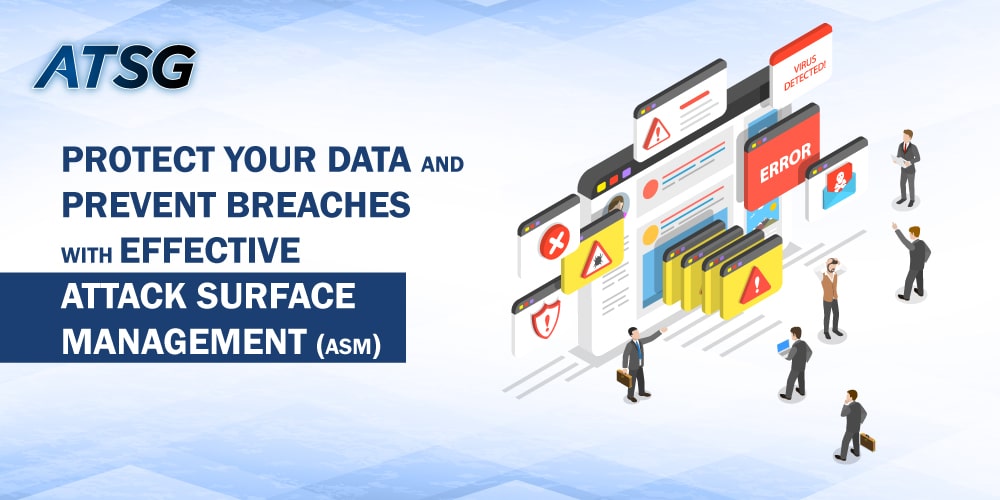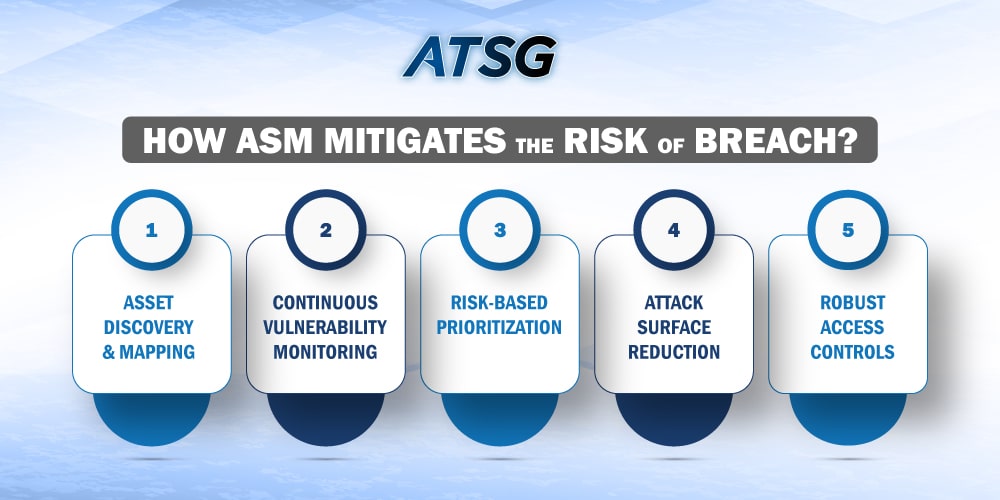Data breaches have become an ever-looming threat to organizations of all sizes. These breaches not only result in financial losses, but also tarnish organization’s reputations and erode customer trust. To combat this menace, businesses must adopt proactive measures to safeguard their data. One such effective approach is Attack Surface Management (ASM), a comprehensive strategy aimed at identifying, assessing, and mitigating potential attack vectors.
In this blog, we’ll delve into the significance of ASM, and its pivotal role in preventing data breaches. We will also explore the Breach Containment and cyber risk Advisory & Assessment capabilities of ATSG.

Introduction to Data Breaches
Data breaches have become a prevalent concern in the digital age, with cybercriminals constantly devising new techniques to infiltrate IT systems, and exfiltrate sensitive information. From financial records to personally identifiable information (PII), no data type is fully immune to these threats. The repercussions of a breach can be devastating, ranging from financial implications to irreversible damage to a brand’s reputation.
Understanding Attack Surface Management (ASM)
ASM serves as a proactive defense mechanism against potential cyber threats, by systematically identifying and reducing an organization’s overall attack surface – the sum of all points where an attacker can infiltrate, and extract, modify or destroy sensitive data. It involves continuous monitoring, assessment, and mitigation of vulnerabilities across networks, applications, and devices. By gaining insights on their attack surface, organizations can fortify their cyber defenses, and stay one step ahead of bad actors.
How ASM Mitigates the Risk of Breach?
ASM plays a pivotal role in breach prevention, by offering a multi-faceted approach to risk mitigation. Below are some strategies to effectively manage the attack surface of your organization:

1. Asset Discovery & Mapping
ASM solutions enable organizations to identify all assets within their infrastructure, including devices, applications, and cloud services. This helps with asset management, and also identifying the inter-dependencies in your IT infrastructure. With this step, businesses can gain better visibility into their attack surface, and identify potential vulnerabilities.
2. Continuous Vulnerability Monitoring
ASM involves real-time monitoring of vulnerabilities across all IT and digital assets. This proactive approach allows organizations to swiftly identify and remediate vulnerabilities, before they can be exploited by threat actors.
3. Risk-Based Prioritization
Not all assets pose an equal risk to the organization. ASM solutions employ risk-based prioritization, to focus resources on addressing the most critical assets first, thereby maximizing the effectiveness of existing cybersecurity measures.
4. Attack Surface Reduction
By systematically eliminating un-necessary or obsolete IT assets and services, ASM helps organizations reduce their attack surface, making it harder for cybercriminals to find entry points within an organization’s IT infrastructure.
5. Robust Access Controls
ASM emphasizes the implementation of robust access controls and user authentication mechanisms, to prevent unauthorized access to sensitive data and resources. Identifying and logging the activities of users also goes a long way in gap analysis, and identifying anomalous behaviors or patterns.
Leveraging ASM for Enhanced Data Security
The implementation of ASM goes beyond mere compliance—it’s a strategic imperative for safeguarding sensitive data, and preserving business continuity (BC). By adopting ASM best practices, organizations can:
-
Enhance Data Protection
ASM helps organizations fortify their defenses against evolving cyber threats, ensuring the confidentiality, integrity, and availability of sensitive data at all times.
-
Improve Compliance
By proactively identifying and addressing vulnerabilities, ASM helps organizations ensure compliance with industry regulations and standards, thereby avoiding costly penalties and sanctions.
-
Safeguard Brand Reputation
By preventing data breaches, ASM helps organizations safeguard their brand reputation, and maintain the trust and confidence of customers, regulators and key stakeholders.
Breach Containment – A Vital Component of ATSG’s Managed Security Portfolio
In the unfortunate event of a data breach, swift and effective breach containment is paramount to minimize the damage and mitigate any further risks to prevent data breaches and exfiltration. ATSG’s Breach Containment capabilities offer organizations a comprehensive suite of tools and services designed to contain and remediate breaches swiftly and effectively. From incident response and forensic analysis, to threat containment and recovery, ATSG ensures that organizations can navigate through a breach with minimal disruption, and maximum resilience.
Advisory & Assessment – Identifying Cybersecurity Gaps
ATSG’s cyber risk Advisory & Assessment capabilities provide organizations with invaluable insights on their existing cybersecurity posture. Through comprehensive vulnerability assessments, penetration testing, and security audits, ATSG helps organizations identify their critical assets and mitigate potential vectors to those assets before they can be exploited by threat actors. By partnering with ATSG, organizations can proactively strengthen their cyber defenses, and stay ahead of emerging threats.
Breach Containment – Provide post-breach measures to stop ransomware attacks
ATSG’s breach containment capabilities provide organizations with the ability to prevent an attacker from moving across the organization in an attempt to gain access to critical assets. Once an organization is breached the attacker can be contained into an area where they can be isolated from any critical infrastructure which prevents them from disrupting operations and accessing critical data. The breach containment provides policies that are dynamic and can change as an application evolves with new services, connections, or cloud migration. Having policies that follow the application and respond to the changes being implemented without complex firewall policies is crucial to establishing a security baseline and ensuring it stays updated as the environment evolves.
Conclusion
Protecting data in today’s challenging digital landscape requires a proactive and multi-layered approach to cybersecurity. Attack Surface Management (ASM) serves as a cornerstone of breach prevention, empowering organizations to identify, assess, and mitigate potential cyber threats, before they can manifest in the form of full-fledged breaches.
By leveraging the Breach Containment, and cyber risk Advisory & Assessment capabilities of ATSG, organizations can bolster their cyber defenses, and safeguard their valuable data, applications, network and critical workloads.
Contact ATSG for fully Managed Security, Managed Operations, Managed Cloud and Managed Network solutions for your organization.




